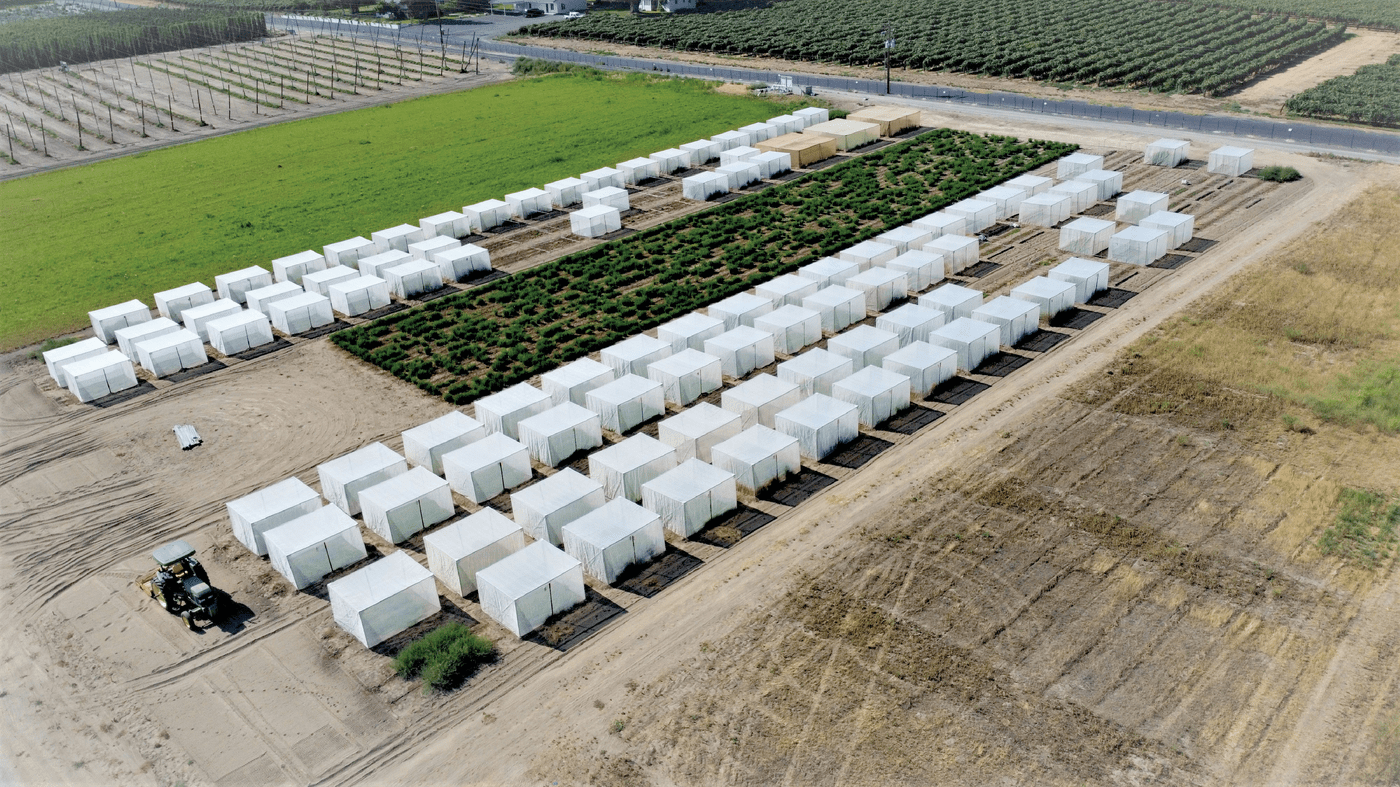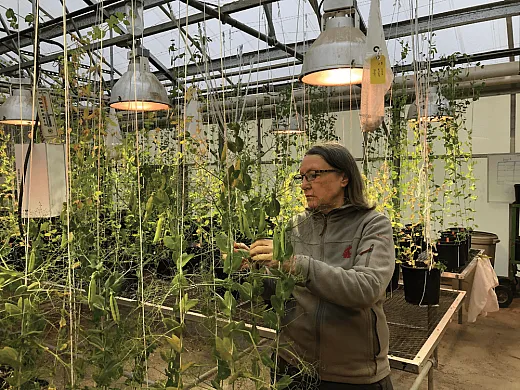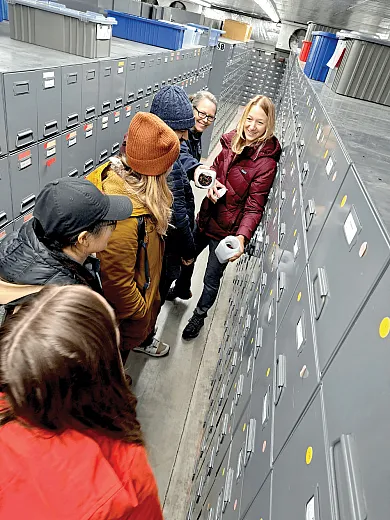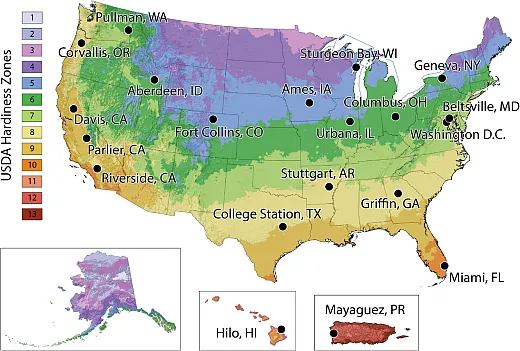Celebrating the Importance of Plant Germplasm

Movement of plant germplasm has taken place since the domestication of crops 8,000–10,000 years ago. People carried their favorite food grains and plants to new environments. In North America, before the arrival of Europeans, indigenous peoples domesticated and exchanged maize, squash, beans, and tobacco. They selected for adaptation to environments as diverse as the Southwest and Midwest United States, Central America, and South America. The same selection occurred throughout the world. Exchange of our major food and forage crops was conducted on a global scale during and following the Columbian exchange of the late 15th century. Many staple crops, including wheat, barley, orchard grass, and alfalfa, were brought into the Americas from Europe and Asia while native species of the Western Hemisphere, including maize, sunflower, blueberries, potato, tomato, peanut, and tobacco, were moved east. Plant exchange continues to impact our diets, our agriculture, and our landscapes.
The U.S. federal government began to coordinate the introduction and exploration of plant material for continued improvement of major food and feed crops in the early 19th century. Plant introductions were welcomed from military and diplomatic expeditions, government exchange, and plant exploration. Plant exploration efforts were formalized when the USDA was established by President Lincoln in 1862. At its founding, one of the Department’s seven main responsibilities was the collection, testing, and distribution of seeds and plants. David Fairchild was hired by the USDA in 1898 as the first chief of The Section of Seed and Plant Introduction, predecessor to our current National Plant Germplasm System.
Honoring Plant Exploration Pioneers at the Annual Meeting
The CSSA Plenary (Betty Klepper Endowed Lectureship) at the CSSA, SSSA, and ASA Annual Meeting in San Antonio on Tuesday, November 12 includes a continental breakfast and features Daniel Stone, author of the highly regarded book The Food Explorer. This book describes the adventures of Fairchild, a man with a passionate love of plants and early appreciation of evolution, who travelled the world to bring us many of the foods we eat and plants that grace our landscapes. Fairchild is credited with the introduction of mangos, dates, avocados, pistachios, and everyone’s favorite farmer’s market staple, kale. Daniel will speak about “Botanical Pioneers: Exploring the Legacies of Fairchild, Meyer, and Popenoe.”
Each year, CSSA honors Frank Meyer with the Frank N. Meyer Medal for Plant Genetic Resources. Meyer, who was a contemporary of Fairchild, collected thousands of plants from Asia and Russia, including the Meyer lemon, the Chinese elm, and 42 soybean introductions, which form the basis of the U.S. soybean industry. He also recommended tofu as an excellent dietary source. He was ahead of this time for many Americans. Our 2024 Meyer Medal Recipient is Dr. Georgia C. Eizenga, Research Geneticist at the USDA‐ARS Dale Bumpers National Rice Research Center in Stuttgart, AR. Georgia has been active in CSSA for many years. Her career has focused on the use of underutilized genetic resources to demonstrate their crop improvement value.
The CSSA Calvin Sperling Lecture honors USDA plant explorer and ethnobotanist Calvin Sperling, who was the U.S. Chief Plant Explorer from 1987 until his premature death in 1995. He led a 1993 United Nations project to conserve plant populations threatened by drought in Ethiopia and was awarded the Frank N. Meyer Medal in 1995. This year the Calvin Sperling Lecture on “Crop Wild Relatives Native to the United States: Current Status to Conserve These Important Genetic Resources” will be given on Wednesday, November 13, by Dr. Stephanie Greene. Stephanie led collecting trips for alfalfa crop wild relatives in Russia, Kazakhstan, and Ukraine, and until recently, she managed the seed collection at the National Laboratory for Genetic Resources Preservation in Ft. Collins, CO.

The Origins of Genebanks in the U.S.

Excepting 1942–1945, annual plant exploration and collection trips have been supported by the USDA since 1898. It was during these early years that O.F. Cook introduced the Plant Introduction (PI) numbering system, which is still in use. Information about the collections included scientific and common name, source of the material, and other notes. These notes formed the early part of the Germplasm Resources Inventory Network Global (GRIN‐global) database.
Early collections were curated and propagated in federal plant introduction gardens. These evolved when the passage of the Research and Marketing Act (RMA) of 1946 led to the establishment of a formal National Cooperative Program to acquire, test, and preserve plant introductions. States were funded to host cooperative Regional Plant Introduction Stations (Ames, IA; Pullman, WA; Geneva, NY; and Griffin, GA) and a National Potato Introduction Station at Sturgeon Bay, WI. The National Seed Storage Laboratory (now the National Center for Genetic Resources Preservation) was established in Ft. Collins, CO in 1958.
The current National Plant Germplasm System (NPGS) is coordinated by the USDA‐ARS, operating from 22 genebanks at 20 locations in cooperation with federal, state, and private organizations. The system manages seed and plant propagules for more than 200 different crops and 600,000 unique germplasm accessions, representing more than 13,000 unique species. Its mission is to maintain, characterize, evaluate, document, enhance, and distribute germplasm. Currently, 87% of the 569,000+ NPGS plant genetic resources (PGR) accessions are available for distribution; in an average year, about 200,000 samples of those accessions are sent to requestors for research, education, and breeding purposes.
In the U.S., the USDA’s National Center for Genetic Resources Preservation (NCGRP) serves as the backup facility for all U.S. genebanks. Holding nearly a half million accessions, the NCGRP stores seed, vegetative, and clonal materials in long‐term storage conditions. It also provides primary or backup storage facilities for the two national seed‐banking networks focusing on native plant collections, Seeds of Success (SOS) and the Center for Plant Conservation (CPC).
Plant Genetic Resources Are Foundational to CSSA Research
Plant germplasm is the foundation of all the work that we do in the Crop Science Society of America. The members of Division C‐8, Plant Genetic Resources, have primary responsibility for the collection, maintenance, and characterization of Plant Genetic Resources, and their research overlaps with the interests of members of Division C‐4, Seed Physiology, Production, and Technology. The plant breeders of C‐1, Crop Breeding and Genetics, and the molecular geneticists of C‐7, Genomics, Molecular Genetics, and Biotechnology, source and characterize the genetic variation from the germplasm collections for their scientific progress. As a wheat breeder, I have often requested germplasm from the National Small Grains Collection in Aberdeen, ID for pre‐breeding, genetic analysis, and novel disease resistance.
Plant germplasm collections are a primary source of novel nutrition and quality characteristics—research conducted by the members of C‐9, Crops for Nutrition and Health. Discerning plant metabolic function in C‐2, Crop Physiology and Metabolism, and plant‐to‐plant interactions in C‐3, Crop Ecology, Management, and Quality, would be incomplete without the variation present within species and passport information curated in our plant collections.
Several native species of interest for improvement of climate‐resilient forage and turf are investigated in C‐6, Forage and Grazinglands, and C‐5, Turfgrass Science. Native species are curated through the SOS national native seed collection program, in cooperation with the Bureau of Land Management. A portion of the seeds of the SOS collections goes into long‐term storage at the NCGRP, and the rest is sent to the USDA‐ARS Plant Germplasm Introduction and Testing Research Unit in Pullman, WA for distribution to interested collaborators.
The CSSA Presidential Award for 2024 goes to Dr. Jim Anderson of the University of Minnesota (UMN), who exemplifies the use of newly introduced accessions into breeding programs. He investigated the Chinese spring wheat cultivar Sumai 3 (PI 481542) to improve resistance to Fusarium head blight and other diseases in wheat. Since 2011 he has managed the Kernza improvement program at UMN, and with colleagues, he recently released ‘MN‐Clearwater’, the first intermediate wheatgrass developed for food consumption. Kernza is the trademarked name for cultivars of Thinopyrum intermedium, or intermediate wheatgrass, that have been improved for grain quality.
The history of Kernza breeding in the U.S. traces directly back to 20 accessions of intermediate wheatgrass that were used as founders in a synthetic breeding program conducted at Rodale Institute, the USDA‐ARS, The Land Institute, and UMN. Nineteen of these 20 accessions came from the NPGS Regional Plant Introduction Station in Pullman, WA. Thinopyrum has also been used as a source of disease resistance genes in wheat. More recently Jim has worked to improve pennycress (Thlaspi arvesnse L.), characterizing 41 natural populations for oil production and other agronomic traits. Several of these populations were also sourced from the NPGS. Jim's research is a notable example of the value of germplasm collections to improved crop cultivars.

Prioritizing and Securing Germplasm Resources
Unfortunately, although collection and access to plant germplasm has been a national priority for most of our nation's existence, funding has often been inadequate to support and maintain these activities. National Plant Germplasm System collections have critical backlogs in securing plant germplasm in long‐term storage, testing plant germplasm quality and health, regenerating plant germplasm, and in the characterization, evaluation of traits, and genetic enhancement of germplasm. In addition, lack of technical knowledge and training for curators, particularly for wild species, limits the scope of the germplasm that the NPGS can safeguard.
Six years ago, the 2018 farm bill directed the USDA to “develop and implement a national strategic germplasm and cultivar collection assessment and utilization plan that takes into consideration the resources and research necessary to address the significant backlog of characterization and maintenance of existing accessions considered to be critical to preserve the viability of, and public access to, germplasm and cultivars.” In response, a National Strategic Germplasm and Cultivar Collection Assessment and Utilization Plan was developed by the National Genetic Resources Advisory Council, the National Plant Germplasm Coordinating Committee, and NPGS staff and leadership. They identified priorities and strategies, developed approaches, and constructed 5‐year and 10‐year timelines to reduce current backlogs, avoid future backlogs, strengthen and increase efficiencies of NPGS operations, improve overall quality for NPGS PGR collections, and comprehensively meet the needs of customers and stakeholders. The full germplasm plan is at https://www.ars‐grin.gov.
The plan is comprehensive, documenting the current state of the collections and plans for improvement to plant germplasm maintenance, characterization, and collection. The plan goes beyond simple storage and maintenance using genomic and phenomic methods for extensive characterization.
As an example, the 2024 Ron Phillips Plant Genetics Lectureship, “Unlocking Nature’s Vault: Innovative Tools for Plant Genebank Analysis,” will be given by Dr. Marilyn Warburton at the Annual Meeting on Monday, November 11. Dr. Warburton is the Director of the Western Regional Plant Introduction Station in Pullman, WA, leading the team that collects, maintains, characterizes, and distributes more than 100,000 accessions of important crops, wild relatives, and native plant species. In her research, she seeks to identify and use natural allelic diversity to increase biotic and abiotic stress resistance and nutritional quality of crop plants.
In a recent Crop Science article (https://doi.org/10.1002/csc2.21003), managers and members of NPGS describe the threats to the current NPGS system due to the changing climate. These threats include direct threats of drought and heat to plant germplasm regeneration activities in ex situ gene banks and to the in situ collections such as wild cranberry, wild chili, and wild grape. Future climate change estimations are used to strategically plan for needed changes. For example, many of the current gene banks were established in prime growing areas for certain species. If these climates change, regeneration and phenotypic characterization will have to be conducted at alternative or multiple locations. One of the primary threats to germplasm is the loss of pollinators. Several of the NPGS locations are focused on supporting and enhancing wild pollinators. The authors point out that the current diverse multi‐location organization of the NPGS is a strength in meeting the challenges to come. They emphasize the need for close coordination across locations and with their state, local, and private partners.
In CSSA and our sister Societies, plant germplasm is fundamental to our research and fundamental to cropping ecosystem health. At the Annual Meeting, we have an opportunity to listen to a set of great speakers and awardees who have strong messages about the importance of plant germplasm. Please plan to attend as many events as possible and consider how you might collaborate to strengthen, preserve, and enhance this valuable resource. More collaboration with state, private, and federal resources is needed to generate information about plant germplasm resources that facilitates their ready use in plant research, crop breeding, molecular genetics, and cropping systems.
Additional Resources
Altendorf, K., Isbell, T., Wyse, D. L., & Anderson, J. A. (2019). Significant variation for seed oil content, fatty acid profile, and seed weight in natural populations of field pennycress (Thlaspi Arvense L.). Industrial Crops and Products, 129, 261–268. https://doi.org/10.1016/j.indcrop.2018.11.054
Bajgain, P., Zhang, X., Jungers, J. M., DeHaan, L. R., Heim, B., Sheaffer, C. C., Wyse, D. L., & Anderson, J. A. (2020). ‘MN‐Clearwater’, the first food‐grade intermediate wheatgrass (Kernza perennial grain) cultivar. Journal of Plant Registrations, 14(3), 288–297. https://doi.org/10.1002/plr2.20042
Crain, J., Wagoner, P., Larson, S., & DeHaan, L. (2024). Origin of current intermediate wheatgrass germplasm being developed for Kernza grain production. Genetic Resources and Crop Evolution. https://doi.org/10.1007/s10722‐024‐01952‐1
Seeds of Success. (2024). Seeds of success: The journey of a seed from collection to restoration. https://storymaps.arcgis.com/stories/8db144a2e5df4c009bfdba130247a6d0
USDA‐ARS. (2023). Conserving the world's plants. https://www.ars.usda.gov/oc/timeline/germplasm/
Volk, G. M., Carver, D., Irish, B. M., Marek, L., Frances, A., Greene, S., Khoury, C. K., Bamberg, J., del Rio, A., Warburton, M. L., & Bretting, P. K. (2023). Safeguarding plant genetic resources in the United States during global climate change. Crop Science, 63, 2274–2296. https://doi.org/10.1002/csc2.21003
Williams, K. A. (2005). An overview of the U.S. National Plant Germplasm System's exploration program. HortScience, 40(2), 297–301. https://doi.org/10.21273/hortsci.40.2.297
Text © . The authors. CC BY-NC-ND 4.0. Except where otherwise noted, images are subject to copyright. Any reuse without express permission from the copyright owner is prohibited.










